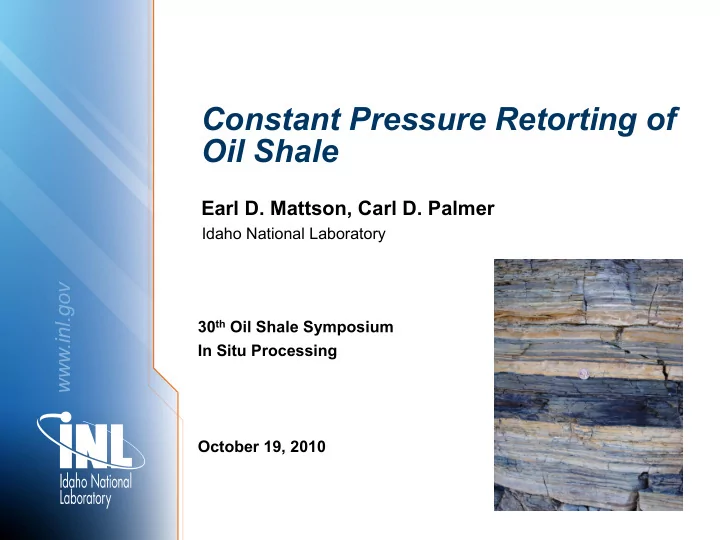

Constant Pressure Retorting of Oil Shale Earl D. Mattson, Carl D. Palmer Idaho National Laboratory www.inl.gov 30 th Oil Shale Symposium In Situ Processing October 19, 2010
Objective : Conduct laboratory constant back pressure oil shale retorting experiments to evaluate the effects of process variables (gas pressure and temperature) on produced fluids. Approach: Retort 150 g crushed oil shale samples in a high pressure/temperature vessel under isothermal and constant pressure conditions. Compare quantity and quality of produced oil, gas, and spent shale.
Major In Situ Controls Retort Gas/Liquid Pressure Energy Input + Time (Temperature Distribution) Product Heat Heat
Constant Pressure Laboratory Set-up References Bae, 69 Noble et al. 81, 82 Burnham et al. 82 Yang and Sohn, 85 shale Max Temp 600°C, Max Pressure 600 psi
TGA Results – Raw vs Retorted Shale ~2% wt loss Retorted • 10°C per min • Nitrogen purge • Ambient to 575°C • < 1 mm particle size Raw ~15% wt loss Decomposition Temperature Ranges Kerogen Bitumen Dolomite/Calcite
Temperature Effects t = exp(13901*(1/(T+273))-16.61)
Results as Function of Temperature Pressure = 200 psi Time = 144, 24, 4 hrs Higher Temperature • More oil generated • More gas generated • More mass removed
Oil Quality Increasing Temperature
TGA Results – Effect of Temperature Lower retorting temperature => less mass removal
Variable Back Pressure Tests • Crushed oil shale Pressure Control • Isothermal (500°C) • 4 hr testing • Variable Back Pressure – 25 to 540 psi
Results as Function of Back Pressure Temp = 500°C Time = 24 hrs @ Higher Back Pressure • Less oil generated • Approximately same gas • More mass removed
Transport vs Decomposition Kinetics Gas Sorption Sequential Sampling Results Retort Pressure 540 psi Four samples after finished Lighter gases tend to adsorb to spent shale Methane ~3X increase Ethane ~2X increase
Oil Quality Increasing Pressure
TGA Results – Effect of Pressure greater gas back pressure => change in distribution
Water Invasion • Fisher Assay type test • Ramp and Soak (500°C) • ~2 hr testing • Back Pressure 25 psi • With and with/out water addition
Fischer Assay Reported FA INL “ FA ” • Container type • Alum. • SS • Container size (L) • 1 / 3 • 1 • Sample mass (g) • 95 (+/-10) • 218.8 • Sample size (mesh) • 8 • 4-10 • Ramp rate ( o C/min) • 12 • ~7 • Backpressure (psig) • 0 • 20-30
FA Results • Red – no water • Blue – 2 ml/min
FA - Comparison w/o H2O w/ H2O
Gas Chromatograph Results – FA Comparison w/o H2O w/ H2O No difference in oil quality
TGA Results – FA Comparison
Summary Comparison of pressure controlled laboratory results • Const. Pressure – Var. Temperature (200 psi, 350-500°C) – At higher retorting temperatures – Possible issue with reaction kinetics – More oil generated – More gas generated – More mass removed – Slightly better quality • Const. Temperature – Var. Back Pressure (500°C, 25-540 psi) – At higher back pressures – Less oil generated – Approximately same gas volume – Less mass removal – Better quality
Summary (cont.) • Transport issues at high pressure – Spent shale appears to adsorb gases similar to CBM – CO 2 storage (~0.04 lbs CO 2 per ton shale per psi) • Water Intrusion Effects – Fisher Assay Results – More oil generated ?? – Same amount of gas generated – Same amount of mass removed – Distribution of kerogen and bitumen may be different (TGA) – No difference in oil quality – More H 2 and CO 2 produced with H 2 O addition • These preliminary results suggest – Operate in situ retorts at lower back pressure without water
Recommend
More recommend